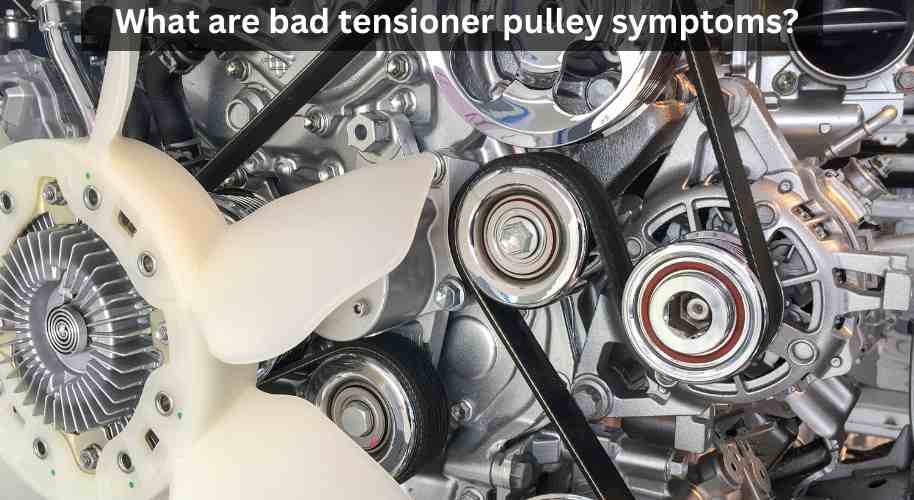Last Updated on March 14, 2023 by Henry T. Hawkins
Symptoms of a bad tensioner pulley include your car being hard to start, loud grinding or screeching sounds coming from the engine, an unsecured engine belt, and decreased power when attempting to accelerate.
But What Are Bad Tensioner Pulley Symptoms? Here, we’ll discuss the signs of a faulty tensioner pulley and how you can tell if it needs to be replaced. So, keep reading!

What Is a Tensioner Pulley?
A tensioner pulley is a tool used in cars to keep the drive belt and other engine components tensioned. This unit consists of a hub, bearing, and housing all integrated together. A series of bolts attach the bearing to its housing, allowing it to move freely and place tension on the belt or chain as necessary.
So, the tensioner pulley provides reliable motion control and constant belt tension in the drive system.
When combined with tensioning elements, these pulleys can be mounted to create a secure belt tensioner. In addition, they increase wrap angle for higher performance transmission across belt drives!
The serpentine belt system in today’s vehicles would not be complete without the tensioner pulley. This essential piece of machinery maintains optimal pressure on the belt as it moves around multiple parts inside your engine, such as the alternator and crankshaft.
The tensioner will deteriorate over time and need to be replaced. That’s why you need to check it frequently.
However, it’s not particularly difficult to replace a tensioner pulley, but you might need specialized equipment, like a pulley removal tool or an impact wrench.
We suggest speaking to an experienced mechanic if you consider replacing this vital engine component.
A professional can also advise you when it’s time to replace the tensioner pulley and any other components in your drive system that might need attention.
Also read: What happens if you use the wrong size battery in a car
What are bad tensioner pulley symptoms?
The tensioner pulley plays an important role in your car, as it keeps the drive belt from getting to wear and tear too quickly. If this part becomes damaged or breaks, other components, like the alternator and water pump, will be subject to extra stress, which could cause them to malfunction sooner than expected.
Here are some common signs of a bad tensioner pulley:
Rattling noises
If you hear a squeaking or rattling sound coming from your engine bay when you start the car, it could be a sign that something is wrong with the tensioner pulley.
This noise is an indication that the belt connected to the tensioner has become loose, consequently not providing enough pressure to ensure a secure fit around the accessory pulleys.
Slipping belt
A slipping belt is another common symptom of a bad tensioner pulley. This usually means that the tensioner cannot keep the belt in place, leading to the belt becoming loose, slipping off, or even breaking.
If this happens, you may also notice an accompanying squealing noise from the engine bay as well.
Vibrations
If your car starts vibrating when it’s running, it could mean that it has a faulty tensioner pulley. Vibrations are caused by misalignments in the drive component system, which can be triggered when a worn-out or damaged tensioner pulley is not exerting enough pressure on the connected drive belts.
Chirping Noise
If you see the car making a chirping noise when the engine is running, it could be due to a bad tensioner pulley. This sound can occur if the bearing inside of the tensioner has become worn or broken and is unable to keep the belt from slipping off.
Lack of power
A bad tensioner pulley can also lead to a lack of power in your car, as it means that the drive belts are not being held securely enough to transfer power effectively between the components. This can result in an overall decrease in performance, especially when you try to accelerate quickly.
Engine Overheating
A bad tensioner pulley can cause the engine to overheat quickly. This is because the serpentine belt is essential for driving many of your vehicle’s engine cooling components, including the water pump, alternator, and power steering pump.
If this belt unexpectedly fails or slips off its track, these key parts will cease to function – resulting in significant overheating as well as a lack of power steering capability.
Check engine light (CEL)
If the timing belt has jumped a few teeth due to tensioner or cogged wear, it can set off your check engine light.
This particular warning signifies that the car’s computer has detected something wrong with the tensioner, and it won’t be able to provide the necessary amount of pressure to keep the connected drive belts in place.
Unlike steel chains, timing belts cannot stretch and need to be replaced as soon as possible when signs of damage begin to surface.
The Car Dies Immediately
If the tensioner pulley has failed completely, then your car might die immediately after starting it. This is because the drive belt connected to the tensioner is essential for powering many of the engine’s components, including those responsible for keeping it running.
Without this belt in place and working correctly, your vehicle won’t be able to generate enough power to keep itself running.
If your vehicle stops working, do not attempt to restart it by yourself. It is best to contact a tow truck or mechanic so that an expert can take care of the problem promptly and safely.
Overall, bad tensioner pulleys can lead to a number of different symptoms, ranging from engine noises and vibrations to dashboard warning lights and even sudden stalling.
If you suspect that there may be something wrong with your car’s tensioner pulley, it’s important that you take it to a mechanic as soon as possible for a proper diagnosis and repair.
This will help ensure that you don’t have to pay out for extensive and expensive repairs later on down the line.
Remember, catching and fixing issues early can save you a lot of time, money and effort in the long run!
Also read: How much hp does the average car have
What are the Risks of Driving with a Faulty Belt Tensioner?
Driving with a damaged belt tensioner is dangerous, considering that it’s designed to give the correct degree of strain needed to power car accessories.
The belt tensioner will eventually slip, make a loud noise, and possibly generate a hazardous amount of heat around its pulleys due to gradual wear and tear.
If the drive belt breaks down while the engine runs, the lack of lubrication may cause the pistons to jam or even freeze up.
The drive belt may also become loose if the tensioner malfunctions while the engine is off, making it impossible to start the engine.
Another risk of driving with a bad belt tensioner is the potential for overheating. All of the parts that the drive belt drives, such as the cooling fan, water pump, and alternator, are kept in position by the belt tensioner.
Without a working tensioner, all of these components will not be able to properly move air through the engine, leading to overheating.
Therefore, getting your belt tensioner replaced as soon as possible is essential if you feel it is not working properly.
How to Replace a Bad Idler Pulley?

Follow the instructions below to replace a bad idler pulley properly.
– The first step is to shut off the engine and give it some time to cool.
– Locate the idler bad pulley’s bracket. While some vehicles may have distinct brackets, others might have a single bracket that holds all the pulleys.
– Using a wrench, loosen the screws holding the idler pulley and bracket in place before removing them.
– Carefully remove the belt from the pulley and set it aside. Make sure the new pulley has the exact same dimensions as the previous one.
– Install the new pulley on the bracket, ensuring that its grooves line up with the belt.
– Reinstall the belt on the pulley. Ensure that the timing belt is positioned correctly
– If everything functions properly, you are successful in replacing the damaged idler pulley.
– Take it to a professional mechanic for further examination if the engine is still not running properly. Keep the bad pulley around as a backup in case you need it.
If you’re feeling up to the task, you can replace the bad idler pulley by yourself or with an assistant’s help.
However, if that seems too daunting for you, then taking it to a professional car mechanic is always an option.
Also read: How long does it take to change a car battery
Wrapping Up
We appreciate you taking the time to read our article on “What are bad tensioner pulley symptoms?” and hope you got the information you were looking for.
In conclusion, we hope that this article has helped answer your query. Although the inquiry “bad tensioner pulley” may be daunting, simply following our advice should make it easy to determine if you need a new tensioner pulley or not.
Most importantly, pay attention to any new irregularities in your vehicle; If not taken care of right away, minor problems can soon become expensive repairs.
Do extensive research on auto-related topics so you are prepared for problems. If the issue is complex, however, don’t hesitate to seek professional assistance for the best results!
